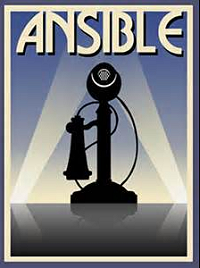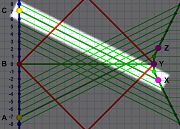SR #24: FTL Radio
 You could call yesterday!
You could call yesterday!Over the last five weeks I've tried to explain and explore Einstein's Theory of Special Relativity. We've seen that motion, velocity, simultaneity, length, and even time, are all relative to your frame of reference and that motion changes the perceptions of those things for observers outside your frame.
All along I've teased the idea that the things I'm showing you demonstrate how the dream of faster-than-light (FTL) travel is (almost certainly) impossible. Despite a lot of science fiction, there probably isn't any warp drive in our futures.
Now it's (finally) time to find out just exactly why that is.
I mentioned last week that the Twins Paradox illustrates the inherent problem with FTL, so let's start there:
 Diagram 1. The Twins Paradox as seen by Al (left) and Em (right).
Diagram 1. The Twins Paradox as seen by Al (left) and Em (right).The diagram above shows the outbound leg of the Twins Paradox where Em and her spaceship are flying away from Al and the Earth. The version on the left shows Al's perspective; the version on the right shows Em's.
Note that the right version is mirror-flipped from the way I've normally drawn Em's frame of reference.
 How Em's frame usually looks.
How Em's frame usually looks.Usually Al's world line (blue) would slant to the left. I wanted to highlight some similarities here, so the diagrams are oriented the same way. The mirror flip of Em's frame doesn't change anything.
A common method of analysis is to assume something is true and then consider the implications of that thing being true. If you can find a contradiction, then your assumption was (very probably) false.[1]
So we'll assume Al and Em possess an "ansible."
An ansible is a fairly well-known science fiction term for FTL radio. The name is due to author Ursula Le Guin. The name also appears in Orson Scott Card's Ender's Game series where it's said that, while the technical term is Philotic Parallax Instantaneous Communicator, everyone calls them "ansibles" after finding the name in some old book.
 Has the first known mention of an ansible!
Has the first known mention of an ansible!Descriptions of ansible devices vary considerably in how they're made and in what capabilities they have. A common basis for their making involves some aspect of quantum entanglement. Their capabilities vary from being very low bandwidth to high, and — in some cases — in where or how they can be used.
Regardless, we'll assume Em and Al have some form of ansible they can use to keep in touch. For the moment we'll assume it's instantaneous (the speed of transmission is another place where ansible descriptions vary).
In diagram 1, notice the thick horizontal "bars" at the top of both diagrams. These bars are intended to represent ansible conversations.
But here's the problem: From Al's point of view (left), he sees Em's arrival at Noether as simultaneous with him. Specifically, his clock reads 12 years, and he knows Em's reads 10.4 (due to her fast motion slowing time from Al's perspective).
 Al's simultaneity with Em.
Al's simultaneity with Em.So Al would expect to converse with Em from his year 12 to her year 10.4, since those are the times Al sees as simultaneous.
But from Em's point of view (right), she sees Al's year 9 as simultaneous with her, so she would expect to converse with Al from her year 10.4 to his year 9.
So who wins?
Perhaps it depends on who places the call. If Al calls Em, he calls from his year 12 to her year 10.4, but if she calls him, she reaches his year 9.
So imagine what happens if Al calls Em (from his year 12) and tells her that, against all odds and expert predictions, the Minnesota Twins won the 2258 World Series!
So then Em calls Al in his year 9 to have him place a large bet on the team!
Or suppose Al reports that something tragic happened back in his year 11, so Em calls his year 9 to instruct him on how to avoid the tragedy.
It seems that assuming ansibles leads directly to a causality violation!
The problem is even worse if Em changes direction relative to Al:
Here Em's spaceship (thick green line on the right) approaches Al and Earth (thick blue line on the left), halts and remains motionless relative to Earth for a while, and then flies off away from Earth.
Because Em is moving (relative to Al), her lines of simultaneity (green lines in middle) are no longer horizontal. As she approaches Earth, she sees Al's "future" as simultaneous with her. When she flies away from Earth, her simultaneity lines are canted into Al's "past."

As Em approaches, at event X (in her year -2), she initiates an ansible call with Al.
This connects her with Al's event C, in his year +7.
Al presumably tells her all about the great advances (and baseball scores) in the last decade or so.
From Em's year -1 to +1 she has stopped (in space or on a planet), and this puts her back in Al's frame of reference. They share the present together, and their clocks tick in synch.

Now their ansibles can communicate with no violation (other than the speed of light, of course) since both share the same simultaneous moments.
(Note how the red light lines show they are communicating much faster than light allows. In fact, in this case, we're assuming ansibles operate instantly. You may recall that early on I said horizontal lines represent instantaneous "movement.")
Finally Em takes off in the opposite direction from Earth which makes her simultaneous with Al's past.

She can presumably fill him in on everything that's going to happen in the next 14 years! (Including that she will talk (or already has talked) to him in their mutual year zero and again in his year +7.)
Which is all obviously a massive violation of causality!
So it's not looking good for ansibles, at least not when one party is moving with respect to the other.
What seems potentially allowed is FTL radio that cannot be used from a moving frame of reference.
Keeping in mind I'm not a physicist and could easily be missing something, I've never seen why FTL radio between observers in the same frame of reference must violate causality.
 Maybe ansibles only work if Em matches her motion to Al's!
Maybe ansibles only work if Em matches her motion to Al's!So one thing a science fiction writer might play with is an ansible that only works once you've matched your frame of reference to the other end.
Perhaps it only has to be "close enough" or perhaps it has to be very precise. The requirement, either way, could make for conflict points.
For example, a ship being chased wouldn't be able to call for help unless they could stop and hide long enough to match vectors with the other end.
It could even be that planetary civilizations must maintain "Ansible Stations" in nearby space because the orbital motion of the planet prevents ansible use on the planet. One might write a series of stories about the exciting life of Ansible Station operators.
Consider this my public domain gift to science fiction writers. All I ask is that you say Ansibles work with "Smythe Waves."

The obvious question at this point is, "What's for dinner?" All I can really say about that is, "I'm not sure yet."
The other question might be, "What about FTL spaceships? Do they do any better?"
No. They don't. That will be the topic next time!
[1] It's worth noting that not everyone accepts proof through contradiction as such proofs require what's called the law of the excluded middle. That is, a logical proposition is either false or true.
Nothing else is allowed; there is no third state. Specifically, if a thing is not true, it must be false, and if it is not false, it must be true.
For most that might seem obvious, but a few logicians resist the notion that if something is not true, it must be false. They do not exclude potential middle states that are neither true nor false.
It's been said that without the excluded middle, most of the truly interesting proofs go away.
